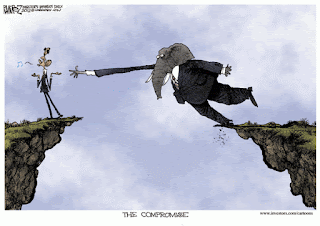The Oklahoman hasn't run any letters the last few days (at least, not in their on-line edition), so I thought I'd take a moment to address another rather annoying aspect of the paper's opinion page: its editorial cartoons.
In its long history, the Oklahoman has one only one Pulitzer Prize: In 1939, it won for Editorial Cartooning. Since then, it's been down hill for the paper. Their long-time cartoonist Jim Lange was, well, awful. This isn't to say that he didn't have talent. He just has no business doing modern editorial cartoons. They featured lots of dead white space, and generally depicted his "everyman"-- an older, balding gentleman with a mustache, bow tie, slacks, and black loafers-- in some state of shock over progressive ideas and politicians. Here's an example:

First off, what is he even saying? That the economy is going down, and so are oil prices? Or, if oil prices go down, then so will the economy? Is he in favor of this? Or just making some sort of economic statement? And why is the "everyman" there? And then, lots and lots of white space. To make it slightly less white, he puts some minor shading.
I want to stress: technically, this is more than sound. The economy of line is great, the composition is good, and the diagonal line gives a bit of action to the image. But compared to modern political cartoons, it's sort of lame. There's no real wit, and it's hard to gauge what the point is.

Here's another. It's titled "Thanksgiving 2002" and the little label says "OUR POST 9-11 'Unity'" next two clasped hands. In the background is part of a waving American flag. To fill all the extra white space, he put some shading and, uh, clouds? Or something.
So what is he getting at? Is "unity" in quotes because he's being sarcastic? Or is he really just trying to say that we're all unified after 9-11 (and, ostensibly, we shouldn't question anything our government does?!?) And what's the giant star on the jacked of the left arm for?
Anyhow, his conservative-leaning cartoons aside, I never thought much of him as an editorial cartoonist. Yet, he and his 1950's style of drawing remained with the paper for something like 58 years.
When he retired, the Oklahoman just started getting random syndicated editorial cartoons, often from Gary Varvel of the Indianapolis Star. Varvel's style is more in line with modern political cartooning:

First, of course, these are in color. I don't know if the physical Oklahoman prints these in color, but that certainly helps the artist deal with white space a bit more. (For instance, he's put a yellow gradient in the door opening. Without color, he'd no doubt want to have put something back there, even if a bit of shading.) But note that he contrasts the computer-shopping husband with nice, simple lines with the haggard mall-shopping wife, who looks frazzled not just via her messed up hair, the broken glasses, missing shoe and missing tooth (!), but even the use of line on her jacket suggests it.
I bring this up just to note that while the Oklahoman has grown up a bit with its cartoons (though one might like them to hire an in-house artist), they're still pushing their ridiculous right-wing propaganda with each cartoon they publish. Moreover, since they have access to syndicated cartoons, they can pick and choose what issues they want to push and have it jibe nicely with their editorials, columns, and, yes, letters, to have a uniform message. Nice, right?
Consider this cartoon:

The meaning is obvious enough: Republicans are trying to compromise on the whole "fiscal cliff" issue, but Obama isn't willing to do the same. Of course, the fact that this isn't true doesn't matter to the Oklahoman. They just want to push their right-wing agenda in as many ways as possible. Note, for instance, that this cartoon ran on December 30, and mirrors exactly the editorial from just a few days prior, where the editors argued
The give and take that's supposed to be part of any negotiation appears, publicly at least, to be mostly a one-way affair in the talks about avoiding the pending “fiscal cliff.”This is comical: so one Oklahoma Congressman suggests that raising taxes may be acceptable, few Republicans agree with him-- including all of the GOP House leadership-- and that is a sign that there is compromise?
Republicans who've long held firm against raising taxes on any Americans are showing a willingness to allow some increases. Rep. Tom Cole, R-Moore, said the GOP should agree now to extend the Bush-era tax rates for the middle class and fight later over rates for the wealthy. Few in the House caucus agreed, but you can't fault a guy for trying.
No comments:
Post a Comment